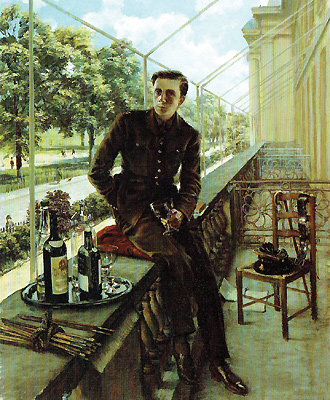|
REX WHISTLER - INSPIRATIONS
by Hugh and Mirabel Cecil
|
 Self-portrait in Uniform
Self-portrait in Uniform |
This is a most beautifully boxed set of two well-illustrated and slim books describing aspects of Rex Whistler’s life and work. The first book, Family, Friendships, Landscapes covers some of his inspirations and from where they derived. There was, of course, Plas Newydd, The Marquess of Anglesey’s house, where Whistler created a magnificent mural as well as falling in love with the Marquess’s daughter, Lady Caroline Paget. And the countryside of Wiltshire and Dorset will come as no surprise to anyone who knows a little of Whistler’s work; this was a place he loved and where many of his friends lived, including Edith Olivier, a middle-aged spinster 30 years’ his senior who was to become his closest friend. Rich landscapes, exquisite pictures of country houses, some grand like Wilton House, some delightfully simple and small, like Ashcombe, leased by Cecil Beaton during the 30s and early 40s. And endless charming swiggles and doodles, book plates, menu cards, fine portraits, and precise drawings, demonstrating just how versatile an artist Whistler was.
The second book, Love and War covers the last few years of his life, a more troubled time for him. By the late 1930s, and in his mid-30s, Whistler had become ‘outstandingly successful, sought after for every kind of artistic commission - for the stage, book jackets, advertisements, as well as for murals which were his passion’. And yet he was not happy. He was ‘in the throes of a passionate obsession with Lady Caroline Paget ... a love which was unrequited’; it seems that he tended ‘to fall for beautiful, complicated women’. Another with whom he was romantically entangled was Ursula Ridley, The Viscountess Ridley, daugher of the architect Edwin Lutyens. And then there were the gathering clouds and the threat from Germany; For Whistler, the thought of war was appalling.
But when war did come in 1939 Whistler was determined to join up as soon as possible. Despite his immense talent as an artist, he did not consider putting his name forward as a possible war artist, and there seems no evidence that Kenneth Clark, responsible for selecting war artists, made any attempt to pursue him. Whistler had a remarkable ability ‘to look at a building, a rural scene, a machine or a statue for a few minutes to be able to sketch it rapidly, in precise detail’. It was, as the authors acknowledge ‘exactly the talent needed on the battlefield’. But Whistler preferred to be a soldier, and so applied to the Welsh Guards for a commission.
The Welsh Guards had scored on at least two counts. Although Whistler had no love for war, he soon turned into a thoroughly sound, approachable, and caring troop commander who looked after his Guardsmen. And his output as an artist seems as prolific as ever, and to the benefit of his regiment. He designed the Welsh Guards’ 1941 Christmas card showing the regimental leek in the centre, with a sketch of the ‘notoriously underpowered’ Cruiser tank below with the slogan ‘Speed up and follow me’. He produced meticulously drawn pictures showing the Correct layout for kit inspection. He painted delightful cartoons of buffoonish ‘Colonel Blimp’ officers to adorn the officers’ mess. He even created a Landscape Target, nearly 9 feet wide, for target identification training. Thankfully a wise instructor concluded that it was far too good to be shot at, and so it was preserved. Whistler painted landscapes of Salisbury Plain, peppered with tiny tanks, superb portraits of fellow officers and a particularly memorable picture of The Master Cook. His painting of the Officers’ Mess tent, Salisbury Plain, gorgeous in its dash of detail, will bring familiar memories back to many post-war soldiers of the 70s and 80s; not much appears to have changed.
Perhaps the most famous of Whistler’s pictures is his Self-portrait in Uniform, painted on the day his Welsh Guards uniform arrived in May 1940. If any one picture or photograph conveys something of Rex Whistler’s anxieties and worries as he embarked on an entirely new venture, it is this one.
The end came quickly and tragically for Rex Whistler. Having trained hard for four years, he crossed to France in late June 1944 with the 2nd Battalion Welsh Guards, equipped with Cromwell tanks. Following a few weeks in reserve, the Battalion was committed to Op GOODWOOD, and on 18th July Whistler and his troop of three tanks were in action. Whatever happened that day might have been avoidable with a little more experience, but the truth is that Whistler, brave to the end, was unlucky. He had climbed from his tank in an attempt to get a message to his troop sergeant. A mortar shell exploded under him, he was blown about ten feet, and was killed instantly. He had been appointed the Burial Officer for the Battalion, and was their first fatality.
There can be little doubt that had Rex Whistler survived the war, his huge talent as an artist would have brought him to even greater prominence; who knows what great pictures he would have painted. Inspirations is a delight. Full of the most lovely images, accompanied by a short and well written text. Buy it as present for a friend, have a peek, and keep it for yourself.
- The Editor
Rex Whistler - Inspirations, by Hugh and Mirabel Cecil, is published by Pimpernel Press Ltd. www.pimpernelpress.com
|
|

